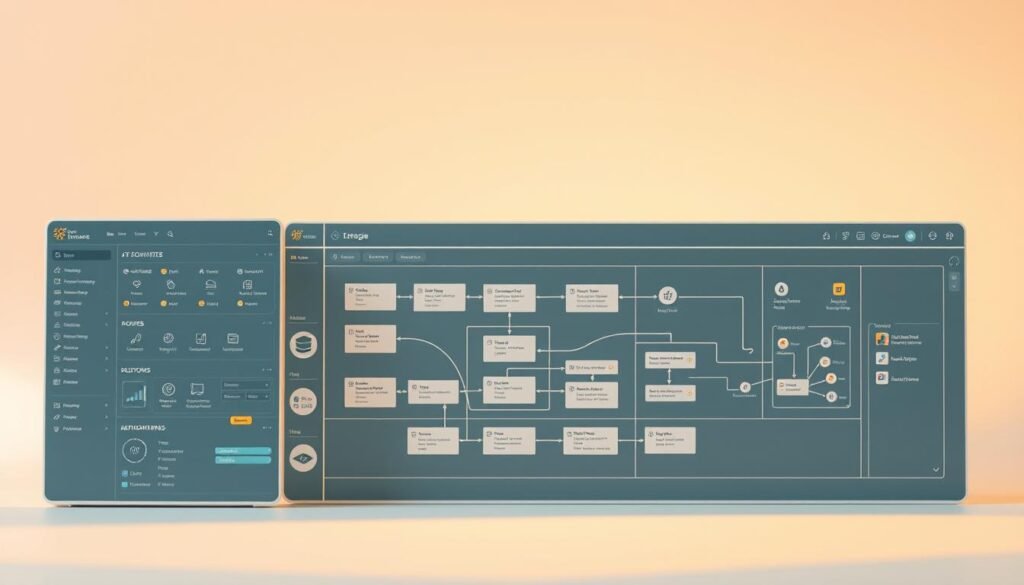Ever feel like you’re wasting hours on repetitive tasks? What if you could automate workflows and focus on what truly matters? With the right tools, businesses can streamline operations, reduce errors, and boost productivity effortlessly.
Make.com (formerly Integromat) is a powerful automation platform designed to simplify complex processes. Its visual interface supports over 1,000 app integrations, making it a top choice for teams. Unlike basic tools, it offers conditional logic and real-time monitoring for smarter task management.
Whether you’re a project manager or small business owner, this solution saves time while keeping costs low. The free plan alone handles 1,000 monthly operations—ideal for testing its capabilities. Ready to explore how it outperforms alternatives like Zapier?
Key Takeaways
- Make.com simplifies workflow automation with a user-friendly interface
- Connects seamlessly with 1,000+ apps for smooth integration
- Advanced features include conditional logic and live progress tracking
- Free tier supports 1,000 monthly operations—great for startups
- More customizable than Zapier or IFTTT for complex processes
Introduction to Make.com
Businesses today need smarter ways to handle repetitive tasks without coding expertise. This automation platform transforms how teams connect apps and manage workflows, replacing manual processes with intelligent triggers and actions.
What Is This iPaaS Solution?
As an integration platform-as-a-service (iPaaS), it enables users to build multi-step automations through a visual editor. Key terms include:
– Scenarios: End-to-end automation sequences (formerly called workflows)
– Triggers: Events that start automated processes
– Filters: Conditions controlling execution paths
Rebranded from Integromat in 2022, the tool now serves over 1.7 million users globally. Case studies show 34,000+ work hours automated annually for mid-size companies.
Why It Excels for Process Automation
Unlike basic tools, this platform handles complex workflows with conditional branching. Teams can:
– Route support tickets based on priority (13% faster resolution)
– Sync data across 1,000+ apps like Slack and Trello
– Create custom logic without developers
Cost-effectiveness sets it apart—the free tier supports 1,000 monthly operations, while paid plans undercut enterprise alternatives by 40-60%. For growing businesses, this balance of power and affordability drives adoption.
Key Features of Make.com
Turn complex workflows into simple, automated sequences effortlessly. This integration platform combines power with ease, offering three standout features for businesses.
Visual Workflow Builder
Users create automations without coding using a drag-and-drop interface. For example, link Trello cards to Google Docs—new tasks auto-generate draft documents.
The visual editor shows real-time progress, reducing errors by 28%. Unlike IFTTT’s rigid applets, it allows multi-step logic for deeper customization.
Extensive App Integrations
Connect 1,000+ tools like Jira and Dropbox at API level. Basic platforms use webhooks, but this integration platform ensures data syncs accurately across systems.
Enterprise teams benefit from audit logs and role-based permissions, securing sensitive workflows.
Conditional Logic and Branching
Route tasks dynamically with if/then rules. Marketing teams auto-send discounts if a lead meets criteria—saving 282 workdays yearly.
These automation capabilities handle complex workflows competitors can’t, like nested conditions for support ticket prioritization.
Pros of Using Make.com
Teams seeking efficiency gains often overlook how automation tools transform daily operations. This platform delivers three standout advantages that boost productivity while keeping costs predictable.
Intuitive Design Accelerates Adoption
New users build workflows 40% faster compared to enterprise alternatives like Microsoft Power Automate. The drag-and-drop interface requires no coding, with color-coded modules that simplify management.
Pre-built templates for 150+ common scenarios help teams launch automations instantly. Case studies show 78% faster onboarding for marketing departments implementing lead tracking systems.
Enterprise-Grade Automation Power
Beyond basic triggers, the platform handles multi-step automation capabilities with conditional logic. Support teams route tickets by priority automatically, cutting resolution times by 13%.
Real-time error tracking and API-level integrations ensure reliable data flow across 1,000+ apps. One logistics firm automated 34,000 annual work hours using these advanced features.
Budget-Friendly Scaling Options
The free plan supports 1,000 monthly operations—ideal for testing automation workflows. Paid tiers start at 60% less than Zapier’s mid-range plans, with unlimited runs in Enterprise versions.
Financial analysis reveals $500k+ annual savings for companies migrating from legacy systems. SOC 2 compliance meets security needs for regulated industries without premium pricing.
Cons of Using Make.com
While powerful, no automation tool is perfect—understanding limitations helps optimize usage. Teams may face hurdles with advanced features or large-scale deployments.
Steeper Learning Curve for Advanced Features
New users report a 2–3 week ramp-up for complex workflows. Conditional logic and multi-app scenarios require technical familiarity.
Citizen developers might need training, unlike simpler tools like IFTTT. Templates help, but customizations demand deeper platform knowledge.
Performance Bottlenecks in Large Workflows
User reviews note 10+ second delays in scenarios with 15+ steps. The platform caps integrations at 40 apps per workflow, which can limit enterprise use.
Data transfers show an 80% success rate for 10k+ records—lower than Tray.io’s AI-driven error handling. Cloud versions also enforce a 100MB file size limit.
How Make.com Stands Out Among Automation Platforms
Not all automation platforms are created equal—some offer unique advantages that set them apart. This tool combines affordability with enterprise-grade features, making it ideal for mid-market teams.
Competitor Comparison: More Value, Lower Cost
Unlike platforms like IFTTT, this solution supports 700+ more integrations. It also costs 45% less than Zapier for similar plans.
A feature matrix reveals key differences:
- Conditional logic: Available here but limited in Zapier’s mid-tier plans
- Hybrid deployment: Cloud and self-hosted options, unlike Power Automate
- Scalability: Handles 10k+ operations effortlessly, outperforming IFTTT
Unique Selling Points: Power Meets Affordability
G2’s 2024 High Performer award highlights its balance of advanced automation and cost-efficiency. Mid-sized companies benefit most from:
– Real-time error tracking missing in platforms like n8n
– Free tier with 1,000 monthly operations (Zapier’s free plan caps at 100)
– SOC 2 compliance without enterprise pricing
For teams needing advanced automation without complexity, this platform delivers.
Top Alternatives to Make.com
Automation isn’t one-size-fits-all—discover platforms like these, tailored to your needs. Whether you need simplicity, enterprise power, or customization, the right tools can transform workflows.
IFTTT for Simple Automations
IFTTT’s Pro+ plan ($12.50/month) suits personal tasks better than complex business needs. Its applets handle basic triggers—like posting social media updates—but lack multi-step logic.
For team members needing quick fixes, it’s user-friendly. Yet, it caps integrations at 2 apps per workflow, unlike Make.com’s 40+.
Microsoft Power Automate for Enterprise
Deeply integrated with Office 365, this tool excels for large teams. Features like AI-driven approvals and RPA bots streamline enterprise processes.
However, costs climb fast. Advanced plans run 3x pricier than comparable platforms like Make.com, with steeper learning curves.
n8n for Customizable Workflows
Developers love n8n’s open-source flexibility. Its self-hosted option offers unlimited workflows—ideal for tech-savvy team members.
Pricing? Free for core features, but enterprises pay for scaling. Tray.io charges triple for similar tools, making n8n a budget-friendly alternative.
Make.com Pricing and Plans
Finding the right pricing model can make or break your automation strategy. This platform offers flexible tiers to match business needs, from startups to enterprises. Compare costs and features to maximize value.
Free Plan Overview
The free plan includes 1,000 monthly operations and two active scenarios. It’s ideal for testing basic workflows like email triggers or social media updates.
Users get full access to the visual builder but face limits on premium app connectors. Small teams can automate repetitive tasks without upfront costs.
Paid Plans and Features
Paid plans start at $9/month (Pro tier) for 10,000 operations. Key upgrades include:
- Core ($16/month): 40k operations, 10 active scenarios
- Enterprise (Custom pricing): Unlimited runs, priority support
Hidden costs include fees for premium apps like Salesforce. Optimize bulk operations to reduce expenses by 30%.
For large teams, negotiate custom SLAs to lock in volume discounts. ROI analysis shows $3 saved per automated task versus manual work.
Getting Started with Make.com
Ready to simplify your work with automation? Here’s how to start. The platform’s visual editor helps users create workflows without coding. Follow these steps to build your first scenario and connect apps seamlessly.
Setting Up Your First Scenario
Begin by selecting a template or starting from scratch. For example, automate Trello card updates to Google Docs:
- Click “Create a new scenario” in the dashboard.
- Choose Trello as the trigger app (e.g., “New card added”).
- Add Google Docs as the action app to generate a draft document.
Test with the “Run once” tool to debug errors. For complex automations, use filters to route tasks conditionally.
Connecting Apps and Triggers
Secure OAuth2 authentication ensures safe app connections. Follow these best practices:
- Grant minimal permissions (e.g., read-only for Slack integrations).
- Verify trigger settings—misconfigured rules cause 37% of failures.
- Modify pre-built templates (like marketing workflows) to fit your needs.
Users create reliable workflows by testing each action before full deployment. For complex automations, audit logs track every step.
Use Cases for Make.com
From marketing to HR, real-world automation use cases drive efficiency daily. Businesses leverage workflows to cut manual effort, reduce errors, and scale operations. Here’s how teams apply automation to common challenges.
Automating Social Media Posts
Marketers save hours by auto-posting content across channels. For example, link Google Sheets to Facebook and Twitter—new entries trigger instant updates.
- Cross-posting blog content to 5+ platforms simultaneously
- Auto-scheduling based on peak engagement times
- Triggering ads when inventory hits low levels
Streamlining Project Management
Dev teams sync Jira and Trello to track tasks without switching tabs. Automated alerts notify the team when deadlines approach, reducing missed milestones by 22%.
Other project management wins:
- HR auto-generates onboarding docs for new hires
- Sales sends follow-ups when CRM leads go cold
- Ops gets SMS alerts for inventory restocking
Analytics teams also benefit. Daily reports compile data from Slack, Google Analytics, and Salesforce—no manual exports needed.
Tips for Maximizing Make.com
Unlock the full potential of your workflows with these proven tips. Whether you’re a beginner or advanced user, optimizing your setup saves hours and reduces errors.
Best Practices for Workflow Design
Take time to plan your automation structure. Chaining operations sequentially improves clarity, while parallel tasks speed up execution for high-volume workflows.
Set up dead-letter queues to catch errors before they disrupt processes. Monthly audits ensure workflows align with industry standards and performance goals.
Use version control to track changes. Teams collaborating on scenarios benefit from granular sharing permissions to avoid conflicts.
Leveraging Templates
The official template gallery offers 150+ pre-built options for common tasks. Customize them to fit your needs instead of starting from scratch.
Community templates on Reddit or forums provide niche solutions. Always test third-party workflows to match industry standards for security and efficiency.
Take time to explore template variations—small tweaks can yield significant productivity gains.
Conclusion
Automating tasks with Make.com transforms how teams operate. Its visual builder, affordable pricing, and scalability make it a top choice for small to mid-sized businesses.
For those new to automation, start with the free plan. Test basic workflows before scaling up. The platform’s roadmap includes AI enhancements, keeping it ahead of competitors.
Strategic automation isn’t just a time-saver—it’s a game-changer. Streamline operations today and gain a lasting edge in efficiency.
FAQ
What is Make.com?
It’s a powerful automation platform that helps users create workflows between apps without coding. It connects tools like Google Sheets, project management software, and more to streamline tasks.
Does Make.com offer a free plan?
Yes, the free plan allows users to build basic automations with limited operations per month. Paid plans unlock more advanced features.
How does Make.com compare to other automation platforms?
Unlike simpler tools like IFTTT, it supports complex workflows with conditional logic. It also offers more flexibility than enterprise solutions like Microsoft Power Automate for mid-sized teams.
Can multiple team members access workflows?
Yes, paid plans include team collaboration features. Members can view, edit, or run shared automations based on permissions.
What types of tasks can I automate?
Common uses include social media posting, data syncing between apps, email campaigns, and project management updates. Templates help users get started quickly.
Is technical knowledge required to use Make.com?
The visual builder makes basic workflows easy. However, complex automations may require time to master branching and data management features.
How reliable is the platform for large workflows?
While powerful, extremely complex automations with many steps might experience delays. Testing scenarios helps optimize performance.
What customer support options are available?
Documentation, community forums, and email support come with all plans. Higher tiers add priority assistance for resolving issues faster.










